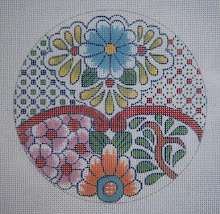 I have had this ready for about two weeks, but had other things to do that I was very slow finishing. I have started some tutorials on the other blog (Freebies, Etc.) about creating plaid patterns, and also planning projects with it, as I'm working on putting my PLAID book into e-book form on my web page.
I have had this ready for about two weeks, but had other things to do that I was very slow finishing. I have started some tutorials on the other blog (Freebies, Etc.) about creating plaid patterns, and also planning projects with it, as I'm working on putting my PLAID book into e-book form on my web page.This is a very very simple plaid, in only orange and red - with elements of white to cool it down. My great grandmother, who lived in Missouri, used to send us a big box of bittersweet from her bushes around her house when I was a child - I loved it! Also, this might be called "pimiento."
Anyway, it's an example of how a simple plaid can be set up for a specific project. This was for a pad on a little footstool my aunt had in her house - hence the curved sides and top. I've been researching Scottish tartans, also, from a very old book I found among her things on this subject - very in depth and fascinating! I say "very old," because it was first published two years before I was born. That classifies it as OLD, but not yet antique. The copy I found was an edition published when I was in college - so it's still "old."
I stitched the Donaldson plaid several years ago for a tote bag, but now can't find it - it was in my favorite blues and greens. One interesting thing I learned is that there can be different color schemes for the individual tartans of different clans, but basically the Sett pattern, which is the area of design that is repeated to construct the Tartan, remains the same within a clan. That is, the pattern is distinctive for that family - but there are hunting plaids in different colors, etc., and now there are even plaids for U.S.A. states, and for Canada and other places.
I even found a Texas Bluebonnet tartan - which captures the kind of purplish blue and bit of magenta and white in these flowers - I want to do something with it, of course! Later.

By the way, the Emperor Marcus Aurelius (one of my favorites besides Emily Dickensen and Ogden Nash) said "the principle that keeps one in everlasting ignorance, is contempt prior to investigation." I know some of my methods are different from what people are being taught now - such as using numbers for some reason to create plaid, or starting in the center and doing horizontals first. ( not a good practice, as it distorts the canvas)
Please feel free, with anything of mine, to try both methods and see which you enjoy, and which is easiest and most effective for you. I strive for simplicity via common sense - and most of my things are just that. If it's tedious and complicated, needlework doesn't fulfill it's purpose. A creative hobby should be pleasurable and relaxing.

No comments:
Post a Comment